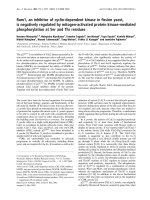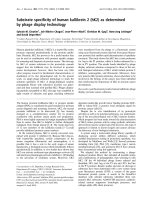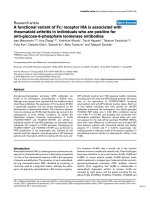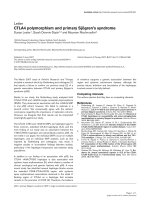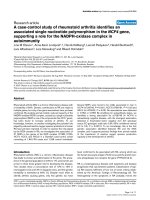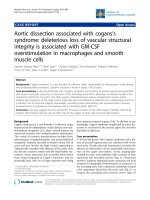Báo cáo y học: "A possible variant of Bouveret’s syndrome presenting as a duodenal stump obstruction by a gallstone after Roux-en-Y gastrectomy: a case report" pot
Bạn đang xem bản rút gọn của tài liệu. Xem và tải ngay bản đầy đủ của tài liệu tại đây (884.31 KB, 3 trang )
Case report
Open Access
A possible variant of Bouveret’s syndrome presenting as a duodenal
stump obstruction by a gallstone after Roux-en-Y gastrectomy:
a case report
Shruti Mittal, Robert P Sutcliffe*, Ashi sh Rohatgi and Simon W Atkinson
Address: Department of Surgery, St Thomas’ Hospital, Lambeth Palace Road, London SE1 7EH, UK
Email: RPS -
* Corresponding author
Published: 28 May 2009 Received: 10 April 2008
Accepted: 23 January 2009
Journal of Medical Case Reports 2009, 3:7301 doi: 10.1186/1752-1947-3-7301
This article is available from: />© 2009 Mittal et al; licensee Cases Network Ltd.
This is an Open Access article distributed under the terms of the Creative Commons Attribution License (
/>which permits unrestricted use, distribution, and reproduction in any medium, provided the original work is properly cited.
Abstract
Introduction: Bouveret’s syndrome is characterized by gastric outlet obstruction due to a gallstone
in the duodenum, usually in association with a cholecystoduodenal fistula.
Case presentation: We report the case of a 69-year-old Caucasian man who developed duodenal
stump obstruction due to an impacted gallstone after having previously undergone Roux-en-Y
gastrectomy.
Conclusions: Duodenal stump obstruction after Roux-en-Y gastrectomy is rare, and may be difficult
to manage. Patients who present with upper gastrointestinal or pancreatobiliary pathology after
previous gastric surgery should be managed in centres with the availability of appropriate endoscopic
and surgical experience.
Introduction
Bouveret’s syndrome is a rare complication of gallstone
disease that is characterized by gastric outlet obstruction sec-
ondary to an impacted galls tone in the d uodenum [1]. This is
usually in association with a cholecystoduodenal fistula [1].
We present an unusual case of duodenal s tump obstruction
by a gallstone in a patient who h ad previously undergone
Billroth II gastrectomy with Roux-en-Y reconstruction.
Case presentation
A 69-year-old Caucasian man presented with intermittent
upper abdominal pain, nausea and bloating for the
previous 12 months. There was no history of fever,
jaundice, pale stools or dark urine. His past medical
history included a Billroth II gastrectomy and Roux-en-Y
reconstruction for peptic ulcer disease 11 years earlier.
On examination, he was haemodynamically stable and
afebrile. Abdominal examination was unremarkable.
Laboratory tests, including liver function tests and
inflammatory markers were all normal. Transabdominal
ultrasound examination revealed gallstones and intra- and
extrahepatic biliary dilatation. Endoscopic retrograde
cholangiopancreatography (ERCP) was unsuccessful.
Magnetic resonance cholangiopancreatogram (MRCP) and
computed tomography (CT) confirmed gallstones within
the gallbladder and biliary dilatation to the level of the
ampulla, and demonstrated a 4 × 3 cm low density filling
defect in the second part of the duodenum (Figure 1).
Page 1 of 3
(page number not for citation purposes)
After he was admitted to a specialist centre, endoscopic
ultrasonography and repeat ERCP were attempted but
failed due to inability to cannulate the duodenal limb of
the Roux-en-Y. Two hours after the procedure he devel-
oped severe, generalized abdominal pain and hypoten-
sion. This raised the possibility of iatrogenic intestinal
perforation. However, it was decided to proceed directly
to laparotomy rather than repeat imaging, since it was
apparent that surgical exploration would be required in
the event of unsuccessful ERCP. During the operation,
there was no evidence of intestinal perforation. A 3.5 cm
gallstone was found proximal to a stricture in the second
part of the duodenum. There was no evidence of a
cholecystoduodenal fistula. The duodenal papilla and
pancreas were normal. The common bile duct, which was
dilated due to extrinsic compression by the intraduodenal
gallstone, was explored and found to be normal, and
contained no stones. The gallstone in the duodenum was
extracted via a duodenotomy, the duodenal stricture was
dilated digitally and a cholecystectomy was performed.
A t-tube was placed in the common bile duct. He made an
uneventful postoperative recovery and was discharged 10
days later after a normal t-tube cholangiogram. The t-tube
was removed six weeks post-operatively.
Discussion
The diagnosis and management of suspected biliary
pathologyinpatientsfollowingaBillrothIIRoux-en-Y
gastrectomy is a considerable challenge. Non-invasive
investigations, such as CT or MRCP may be helpful to
detect intraductal stones and exclude other pathologies.
In view of the distorted anatomy, an ERCP should be
performed by an experienced endoscopist in a centre with
access to surgical and radiological support [2]. Retrograde
cannulation of the papilla may be possible in some
patients, but in cases of difficulty, the procedure should
be abandoned early to reduce the risk of small bowel
perforation. A forward-viewing endoscope may be safer
than a side-viewing endoscope in this group of patients and
has been recommende d previously [3]. Per cutaneous
transhepatic cholangiography followed by sequential dila-
tation and percutaneous cholangioscopy has been reported
to be successful, and may be an option for patients unfit
for surgery [4]. Surgical exploration of the common bile
duct is necessary where endoscopic and percutaneous
techniques are unsuccessful. Reoperation in these patients
poses a significant risk of inadvertent gastrointestinal
injury due to the presence of adhesions.
Bouveret’s syndrome is a rare complication of gallstone
disease [1], and is characterized by passage of a large stone
through a cholecystoduodenal fistula into the duodenum,
which becomes impacted. Patients typically present with
features of gastric outlet obstruction. A barium meal and/
or endoscopy may confirm the diagnosis, and endoscopic
disimpaction may be possible, but surgery is frequently
necessary. Cholecystectomy carries no benefit in these
cases, and is often very difficult and should be avoided.
This case is an unusual variant of Bouveret’s syndrome
with some interesting differences. There have been reports
of gallstones causing affe rent loop obstruction after
Billroth II gastrectomy in patients with a cholecystoduo-
denal fistula [5]. In our patient, a large gallstone became
impacted in the duodenum in the absence of a fistula. The
most likely explanation in our patient is that multiple
small stones passed from the gallbladder into the
duodenum via the papilla and became enlarged by a
process of accretion as a result of the stricture in D2,
ultimately leading to obstruction of the duodenal stump.
Figure 1. Magnetic resonance cholangiopancreatography
(a) and computed tomography (b) images showing a
large filling defect in the duodenal stump, which had
caused duodenal stump obstruction and extrinsic bile
duct compression.
Page 2 of 3
(page number not for citation purposes)
Journal of Medical Case Reports 2009, 3:7301 />The aetiology of the duodenal stricture was unclear, but it
may have been inflammatory or due to adhesions. Since
the patient had previously had a Roux-en-Y reconstruc-
tion, the gallstone caused duodenal stump obstruction,
resulting in abdominal pain, rather than gastric outlet
obstruction as originally described by Bouveret. There
was no evidence of a cholecystoduodenal fistula, and
therefore cholecystectomy could be safely undertaken in
this patient.
Conclusion
Investigation of the biliary tree after Roux-en-Y gastrect-
omy presents a significant challenge. Noninvasive ima-
ging, such as CT or MRCP may provide useful information
to guide management. ERCP may be possible but should
be performed by an experienced endoscopist in a specialist
centre with availability of radiological and surgical
expertise. In the presented case, an impacted gallstone in
the duodenal stump could not be removed endoscopically
and required surgical intervention.
Consent
Written informed consent was obtained from the patient
for publication of this case report and any accompanying
images. A copy of the written consent is available for
review by the Editor-in-Chief of this journal.
Competing interests
The authors declare that they have no competing interests.
Authors’ contributions
SM and RS collected the data and drafted the manuscript.
AR performed a literature review and helped draft the
manuscript. SA conceived the study. All authors have read
and approved the final manuscript.
References
1. Cappell MS, Davis M: Characterization of Bouveret’s syndrome:
a comprehensive review of 128 cases. Am J Gastroenterol 2006,
101:2139-2146.
2. Hintze RE, Adler A, Veltzke W, Abou-Rebyeh H: Endoscopic access
to the papilla of Vater for endoscopic retrograde cholangio-
pancreatography in patients with billroth II or Roux-en-Y
gastrojejunostomy. Endoscopy 1997, 29:69-73.
3. Kim MH, Lee SK, Lee MH, Myung SJ, Yoo BM, Seo DW, Min YI:
Endoscopic retrograde cholangiopancreatography and nee-
dle-knife sphincterotomy in patients with Billroth II gastrect-
omy: a comparative study of the forward-viewing endoscope
and the side-viewing duodenoscope. Endoscopy 1997, 29:82-85.
4. Galloway SW, Chan AC, Chung SC: Transhepatic balloon
sphincteroplasty for bile duct stones after total gastrectomy.
Surg Endosc 2000, 14:966.
5. Dias AR, Lopes RI: Biliary stone causing afferent loop syndrome
and pancreatitis. World J Gastroenterol 2006, 12:6229-6231.
Page 3 of 3
(page number not for citation purposes)
Journal of Medical Case Reports 2009, 3:7301 />Do you have a case to share?
Submit your case report today
• Rapid peer review
• Fast publication
• PubMed indexing
• Inclusion in Cases Database
Any patient, any case, can teach us
something
www.casesnetwork.com

